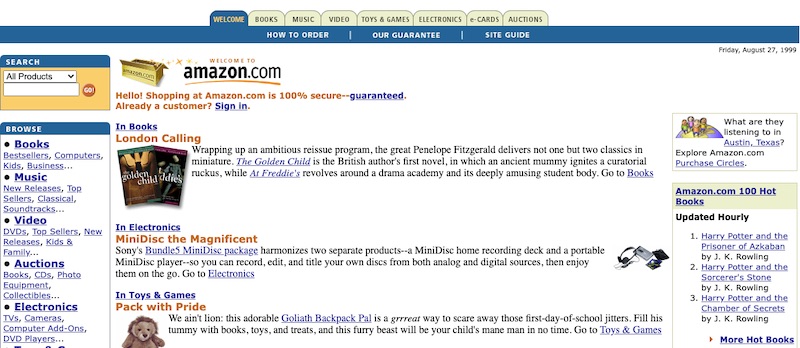
Platforms such as Ebay, Amazon, and Etsy have steadily grown in popularity. This screenshot of Amazon’s home page is from August 1999. The site sold mostly books then. Source: Wayback Machine.
Designing, building, and launching a website is just the beginning of an ecommerce business. Attracting and converting visitors is the next, all-important step. A website alone does not guarantee anything.
This is where marketing comes in. Consumers need to find your site and, once there, have a reason to buy from you. Traffic from search engines — via organic listings and ads — can help with the former. Other marketing tools include email and ads on Facebook, Instagram, YouTube, and many other websites.
But the most critical factor in long-term success is the ability to change and adapt. Plan for change from the start. Don’t build an ecommerce site that is difficult (expensive) to alter or redo. It limits your potential.
The Basics
At the basic level, a site needs fresh content — product descriptions, photos, videos, prices — to help visitors make an initial purchase decision and return for more. For some markets, this is easy. Take shaving. Consumers will always need razors. But even razors have innovations and new ideas, such as three blades or five blades or auto-restocks via subscriptions.
Most products have new or upgraded releases and alternative uses. If your site is quick to receive these updates, compose compelling descriptions of why they are better or different or exciting. You have then given shoppers reasons to keep coming back. Some sites do this with blog posts and news articles.
In my business of selling science fiction memorabilia, an individual staff member knew all about new products and could write clever and funny descriptions about them. This made my site stand out and gain more customers. It helps if your ecommerce site can integrate with a publishing platform such as WordPress. (Or perhaps WordPress is also your ecommerce platform via a plugin, such as WooCommerce.)
Evolution
Over time the accepted look and feel of ecommerce sites evolve. What was once a good-looking site can become dated and stale. Visitors need to feel confident that you are a reliable business — their money is safe, and you will deliver what you say. New customers tend to evaluate a site based on its appearance. It’s difficult, however, for an insider to look at a site with fresh eyes, as new a visitor would see it. But it’s essential.
Perhaps your site requires a new template. Maybe the menu structure or navigation needs a revamp. You may need to move to a new platform to keep the site looking modern. These changes are relatively straightforward if you have planned, ensured that the content is portable, and maintained control.
What was once a good looking site can become dated and stale.
Strategic
When I launched in 2000, most online transactions were done from individual websites. All I had to do was make sure that mine was better than my competitors and appeared higher on the search results. In time, however, third-party platforms such as Ebay, Amazon, and Etsy began to dominate.
Thus the final type of change is strategic. Decide whether to list your products on these platforms. The decision is not easy. Do you list all of your products on those channels or just the bestsellers or clearance items? Do you set the same prices across channels or make the items on your own site cheaper? Can you vary prices in this manner without violating the third-party platform’s rules? In the E.U., for example, it is illegal for Amazon to forbid sellers from setting lower prices elsewhere.
Further, listing on third-party platforms creates competition for your own site. But can you afford not to use these platforms?
Consider the risks, too, such as being at the whim of the platform. Initially, Amazon was a small percentage of my sales, but it grew to exceed 75 percent. Staying on Amazon’s good side became vital — even to the point of putting Amazon’s shoppers ahead of those from my own site.
Inevitable Change
The point is that change is inevitable. Any company that does not evolve will surely die. Remember that the purpose of your business is to earn profits. Your website is a tool to make money. Change it or, indeed, move away from it as needed.







